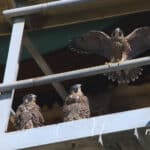Love them or hate them, Alameda has a growing population of urban turkeys. Where there were a few scattered pairs 10 to 15 years ago, there are now at least three flocks with 10 or more turkeys per flock. They continue to grow each spring. There seems to be a flock on the East End near High Street, a flock around Grand Street, and another flock on the West End. There may be more than these, with flocks on Bay Farm Island and other scattered birds.

No one is sure of how the turkeys first came to Alameda—did they fly over the Estuary or walk over a bridge? The turkey’s history in California is an interesting one. The turkeys we see now are not native to California. Turkey fossils, which are common in the La Brea Tar Pits, reveal a stockier species that is estimated to have gone extinct around 10,000 years ago. Turkeys are a game animal, and after repeated attempts to introduce turkeys to California for hunting, wild turkeys became established by the late 1950s, starting along the Central Coast. Turkeys have expanded their range and are present in at least 54 of California’s 58 counties. The population of wild turkeys in California is estimated at roughly a quarter-million birds.

Turkeys are large birds, with a five-foot wingspan and weighing up to 20 pounds. Their feathers are dark overall, with a bronze/green iridescence. Their small heads are bare with the head skin colored blue, red, gray, or a mixture. The male turkey has bare growths on its neck, called wattles, a growth over its beak called a snood, and a “beard” or tuft of feathers growing out from its breast. It also has spurs on its legs that it uses to fight other males for dominance.
Turkeys breed in the spring, and males often court the females in groups. Dominant male turkeys do most of the mating with the females. Nesting and raising the chicks is left to the females, who lay 10 to 15 eggs, one egg a day, in a shallow depression in grasses or bushes. Incubation starts when all the eggs are laid and lasts about 28 days. All of the eggs hatch at once. When the eggs hatch, the chicks are covered in down and feathers. Their eyes are open, and they can leave the nest within a few hours.
The young turkeys, called poults, are very vulnerable at that point. The poults travel in a family group with their mother for several months, often combining with other family groups. The hens teach the chicks to find food and stay with the poults as they grow. Turkey predators in Alameda include skunks, racoons, and opossums—which mainly eat eggs and poults—along with larger hawks and Great Horned Owls. We don’t have coyotes, bobcats, or other predators that would prey on adult turkeys and help keep the population numbers lower.

Wild turkeys mostly forage on the ground, although they will climb into shrubs to get fruit. Their primary diet is plant material, including seeds and nuts. They supplement their diet with salamanders, snails, and insects.
They can fly short distances and swim when necessary, but prefer to walk and can run quickly. At night, they fly into trees to roost, usually in flocks but sometimes singly. We’ve heard of night roosts on Thompson Avenue (aka Christmas Tree Lane) and over near Franklin Park.

If you’d like to help track the turkey flocks in Alameda, a couple of options are available. You can use eBird to log your sightings, and keep track of other local birds as well. That’s a very helpful activity as it provides scientists with data to help track and assess bird species and their populations. Facebook has a public Turkey Spotting in Alameda group where you can enjoy local turkey photos and locations, and add your own. As with all urban wildlife, our turkeys can pose some problems, such as stopping traffic, messing up people’s yards and parked vehicles, and menacing pedestrians and bike riders. So far, we haven’t heard of many negative interactions, but if you need them to go away, they apparently respond to loud noises—banging pots and pans, somewhat like scaring off a bear in Yosemite—or opening and closing an umbrella toward them. We hope you’ll appreciate the unique opportunity to have wildlife close to our urban lives and just enjoy their presence.

Learn more about our local bird life on free walks offered by Golden Gate Bird Alliance (formerly Audubon), including monthly guided walks on the Corica Park Golf Course.
Linda Carloni, Sharol Nelson-Embry, and Rick Lewis are volunteers with Friends of the Alameda Wildlife Reserve (FAWR), a Conservation Committee with Golden Gate Bird Alliance (Formerly Audubon). This article is part of a monthly series of articles highlighting Alameda’s nature and wildlife.



